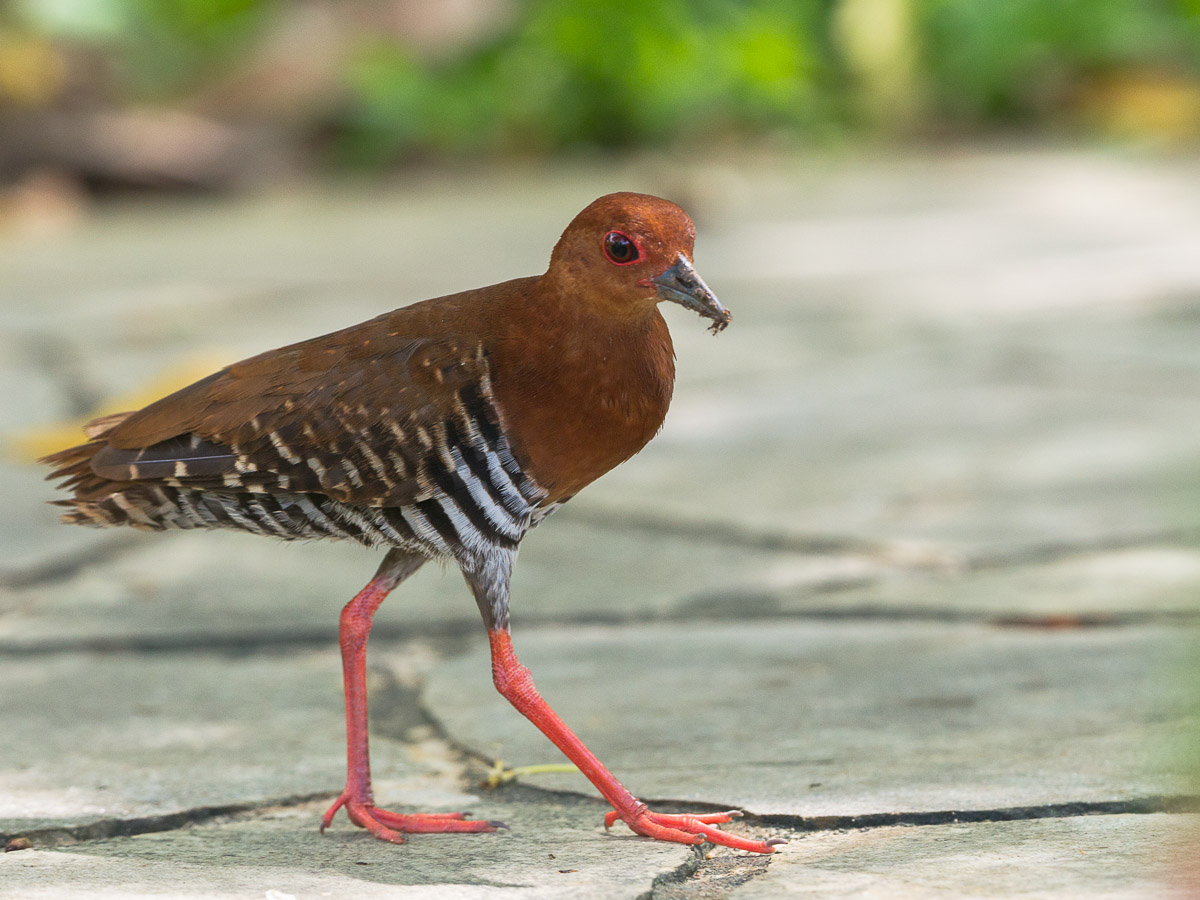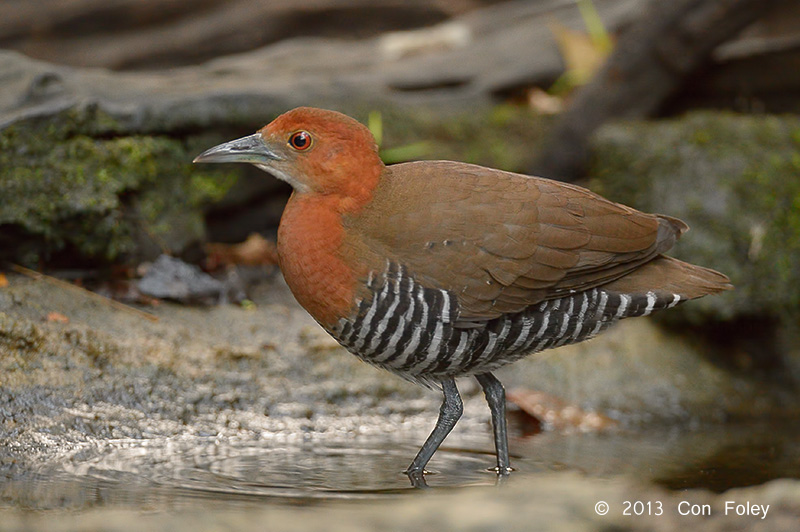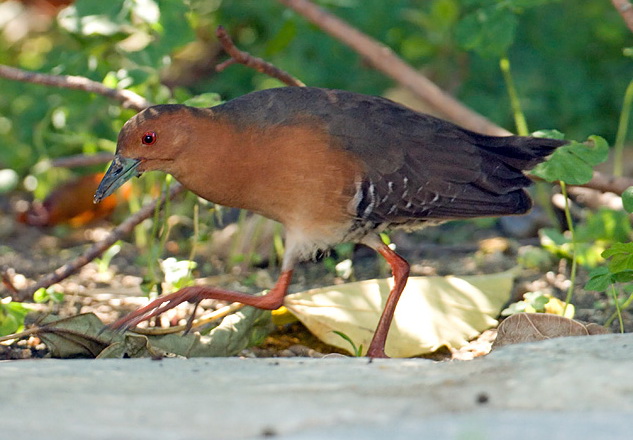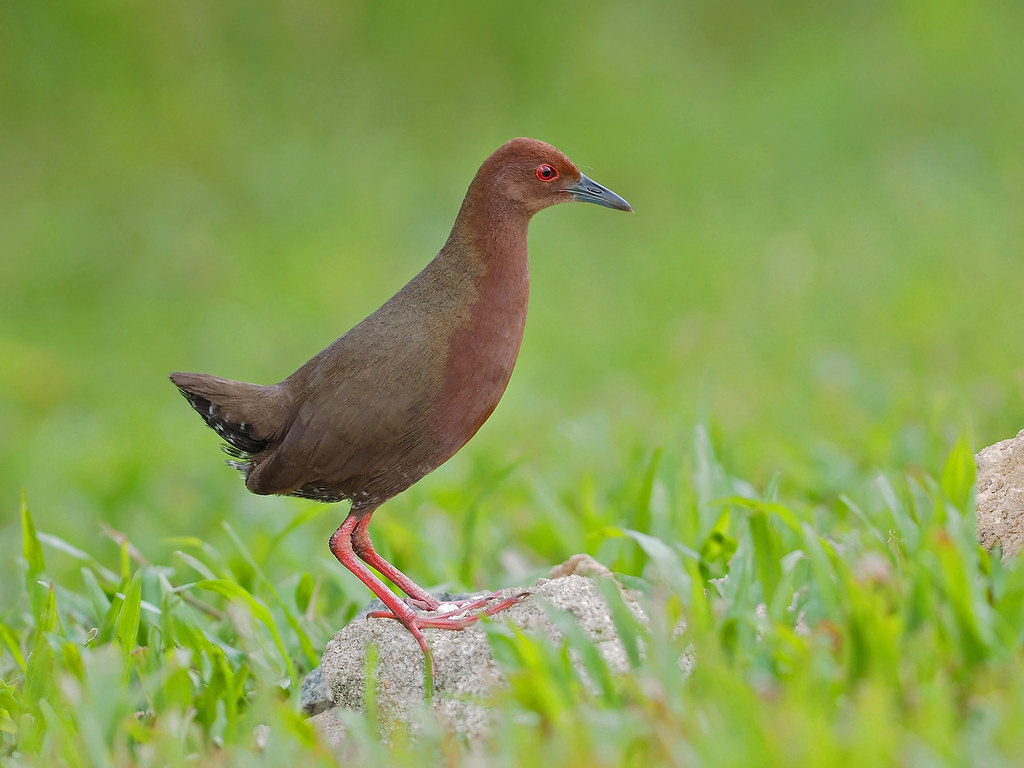Rallina fasciata (Raffles, 1822)
Table of Contents
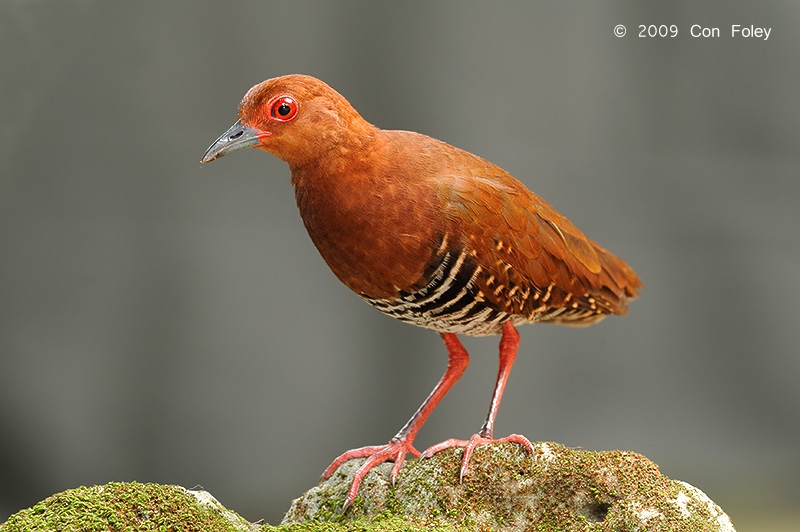 |
| Figure 1. Photograph of a Red-legged Crake taken at the Singapore Botanic Gardens. Photo by Con Foley (2009) © |
Introduction
The Red-legged Crake is a medium-large bird found in the family Rallidae. The word 'crake' is usually applied to species which are smaller in size and have shorter bills in the family [1]. Like all the other Rallidae birds, the Red-legged Crake is a rather cryptic and secretive bird, and is rarely seen [2]. It is native to many Southeast Asian countries, including Indonesia, Thailand, Malaysia and Singapore [3]. They reside in terrestrial wetland habitats, often in dense vegetation, and mostly appear in open areas during dusk. Other common names of this bird include the Malaysian (Banded) Crake, Malay (Banded) Crake, Malay (Banded) Rail, Red-legged Banded Crake and Red-legged Chestnut Rail [4] [21].Description and Identification
From Taylor (1998) unless otherwise stated.For information on bird topography, click here.
Figure 2 points out some distinctive features of the adult Red-legged Crake for field identification purposes. Table 1 presents the detailed descriptions and comparison of the adult and juvenile Red-legged Crake. Figure 3 gives a detailed representation on the upper and lower parts of the adult Red-legged Crake. Adults are usually 22-25 cm in size [1].
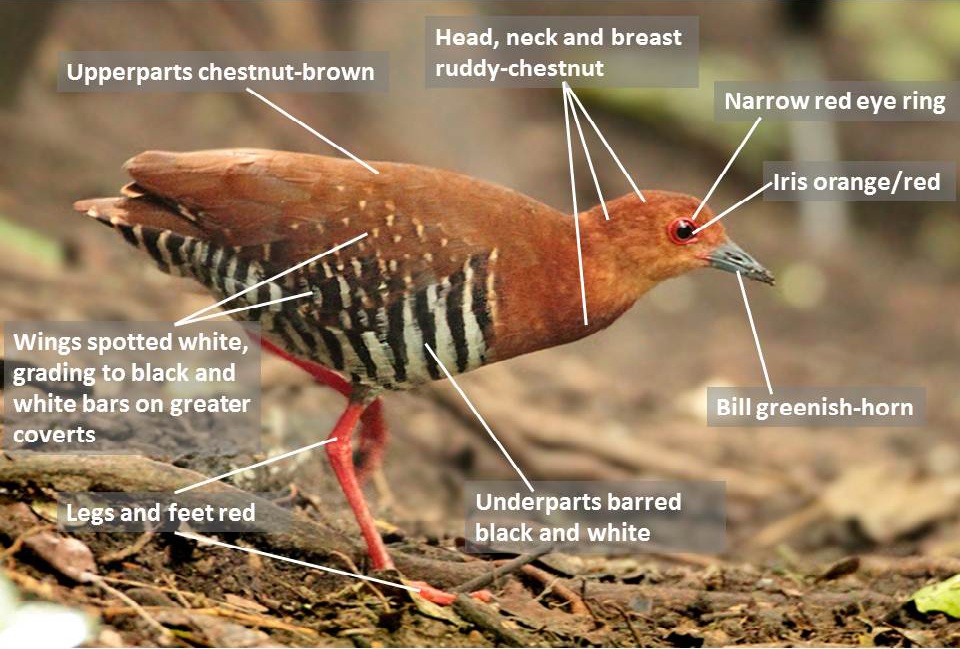 |
| Figure 2. A photo of a Red-legged Crake with labelled body parts. Photo by Albert Noorlander © (Permission Pending) and edited by Soo Yun Jing. |
Table 1. Detailed description of the features of adult and juvenile Red-legged Crake
| Body Part(s) |
Adult |
Juvenile |
|---|---|---|
| Head, neck and upper breast |
|
|
| Bill |
|
|
| Chin and throat |
|
|
| Upperparts (including scapulars, upper-wing coverts, inner secondaries and tail) |
|
|
| Eyes (including iris and eye-ring) |
|
|
| Legs and feet |
|
|
| Scapulars |
|
|
| Primaries and secondaries |
|
|
| Outer wing coverts (including upperwing coverts, secondary and primary coverts, greater coverts, tertials and alula) |
|
|
| Underwing-coverts and axillaries |
|
|
| Underparts and lower breast (including flanks) |
|
|
| Undertail-coverts |
|
|
| Thighs |
|
|
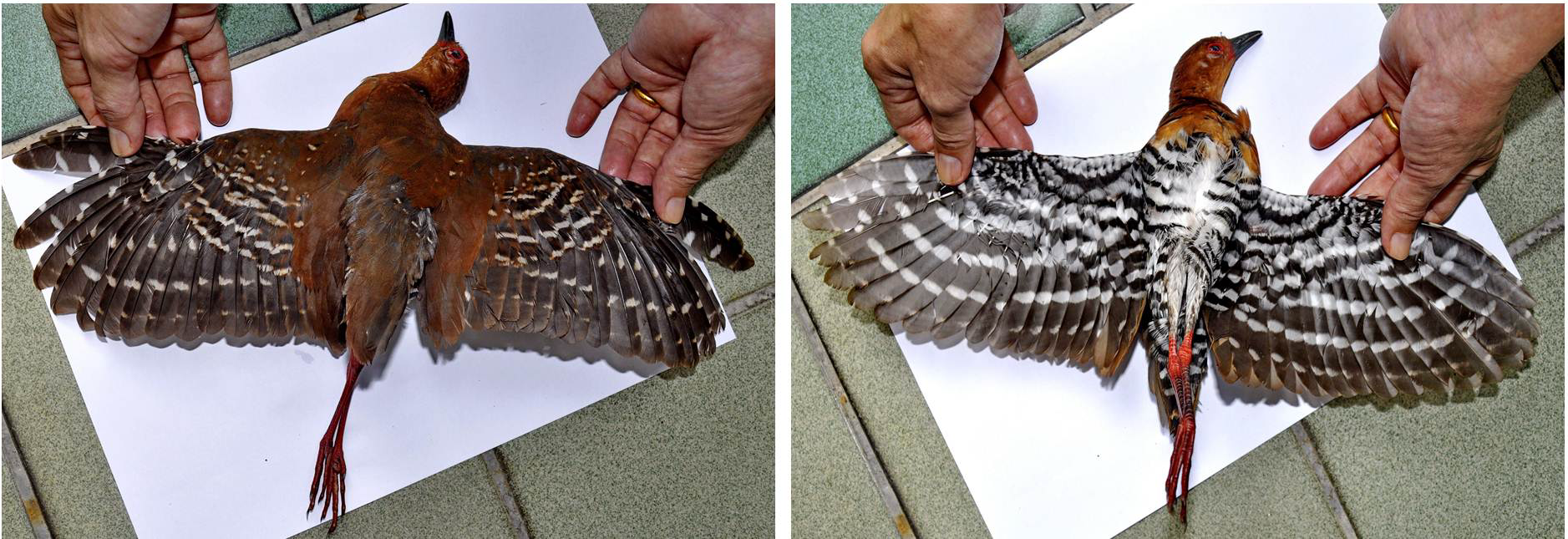 |
| Figure 3. Upperparts (left) and underparts (left) with wings spread of a Red-legged Crake. Photos by Amar-Singh HSS © |
It is often hard to distinguish between the males and females. Adult females are more cinnamon-coloured and less chestnut-coloured on head and neck, and have narrower black bars on belly and flanks. Adult males have a paler chin and throat as compared to the adult females.
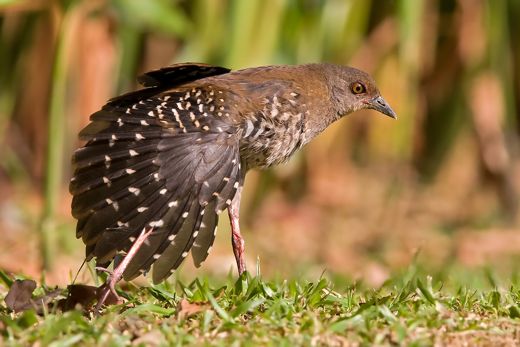 |
| Figure 4. Picture of a juvenile stretching its wings. Photo by Eric Tan © |
Figure 4 shows a picture of a juvenile Red-legged Crake. Detailed descriptions of the juvenile body parts can be found in Table 1. The downy young of the Red-legged Crake is not described above, but it has a general dark smoky-brown plumage. Watch a video of an adult and a downy young below.
Diagnosis
There are a few species of crakes under the Rallidae family that are morphologically similar to the Red-legged Crake. This section highlights some of the diagnostic and distinguishing characters of the Red-legged Crake and a few other similar species which have overlapping range.
|
Figure 5. Red-legged Crake (Rallina fasciata)
|
||
|
Figure 6. Slaty-legged Crake (Rallina eurizonoides)
|
||
|
Figure 7. Band-bellied Crake (Porzana paykullii)
|
||
|
Figure 8. Ruddy-breasted Crake (Porzana fusca)
|
Vocalisation
The Red-legged Crake gives out calls at night, a loud "gogogogok". This call can also be heard during rainy days, coupled with a "girrrrrr". During breeding season, territorial calls are made during dusk and dawn, and the calls are few nasal "pek", repeated at about every 0.5s [1] with a slow descending trill [5]. Callings of the bird have been reported during May to August, and usually heard near scrub or closed woodlands [6].Here are two different types of calls of the Red-legged Crake retrieved from xeno-canto :
Call 1 :
Call 2 :
Distribution
Global Range
The global range of the Red-legged Crake includes the far-North Eastern Indian subcontinent, Lanyu Island in Taiwan, Myanmar, Western Thailand and Southern Vietnam to the Greater Sunda Islands and Phillipines, Lombok, fores and Kisar on the Lesser Sunda Islands and Moluccas [6], which equates to a distribution area of about 2,040,000 km2 [7]. They are sometimes found as vagrants in Palau in Western Micronesia and Australia [6]. Recently, it was found breeding in West Timor [4]. Figure 9 presents the range distribution of the Red-legged Crake.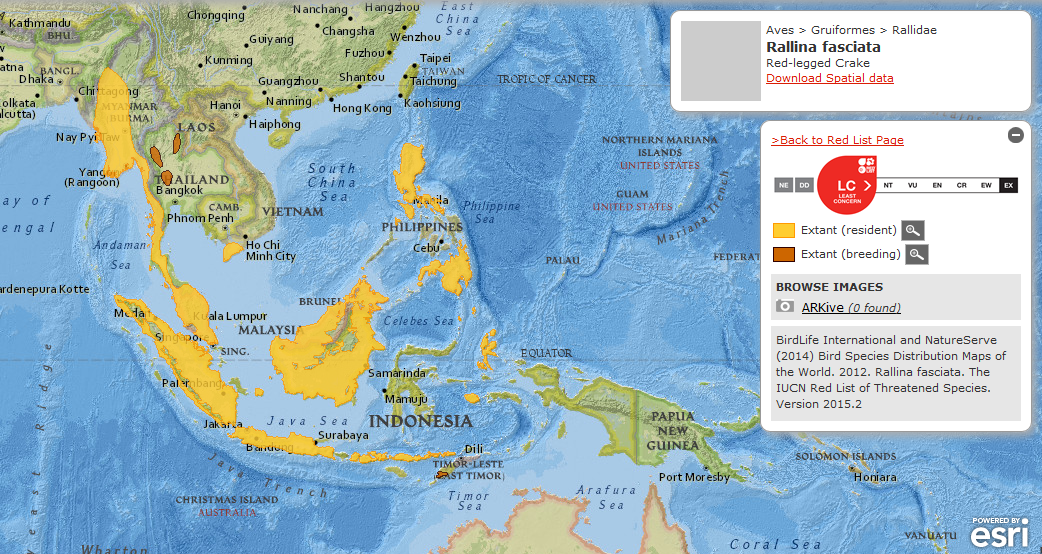 |
| Figure 9. Map on the distribution of the Red-legged Crake. Image adapted from the IUCN. |
Migrations of the bird are hard to follow as they seem to overwinter at the southern parts of the range, and are both residents and migrants in the normal range. Their dispersal and migration patterns might be based on water level and food availabilities. Furthermore, they migrate at night, which makes their migratory behaviour and route more difficult to track and study [5]. However, some migratory movements have been recorded from peninsular Malaysia in October to December and April to May [1]. Read more about avian migration and dispersal behaviour here.
In Singapore
 |
| Figure 10. A Photo of a Red-legged Crake. Photo by Eric Tan © |
Unfortunately, there have also been many reports of roadkills, and many dead carcasses of the Red-legged Crakes have been photographed in recent years. These deaths were most probably caused by road accidents of passing vehicles when the birds tried to move from one vegetation patch to another by crossing the road. For more information on roadkills of the Red-legged Crake, visit here and here.
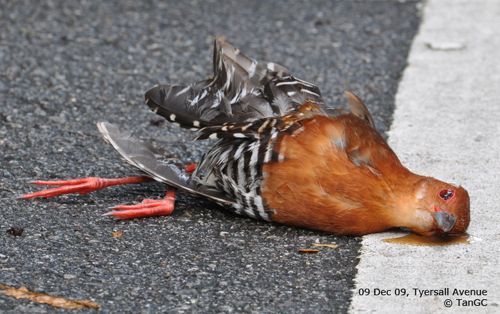 |
| Figure 11. A dead Red-legged Crake. Photo by Tan GC © (2009) (Pending Permission) |
Biology
Habitat
Birds under the family Rallidae are mostly found in wetlands [1]. The Red-legged Crake is terrestrial in nature and can also be found at wetlands such as swamps and marshes with reeds, ricefields, rivers and streams, riparian wet areas in the forest, and also in thickets and secondary growths [5]. It is not often found in open areas. In the Phillipines, it also occurs in open hillsides and cogon grasslands [1].
The video on the right shows a Red-legged Crake bathing on a late afternoon at the Lung Sin Waterhole, near Kaeng Krachan NP, Thailand. The bird has been observed to be a regular at this location in the wet season, and was filmed on 29 June 2015.
Behaviour
There is very limited information on the social behaviour of this bird, as the Red-legged Crake is shy, retiring, and difficult to flush [1]. The bird is usually encountered as single adults, with or without juveniles [6]. The Red-legged Crake likes to forage under vegetation cover and emerges out to more open areas at dusk. Like all other species in the Rallidae family, the Red-legged Crake has laboured and fluttering flight. However, they are capable of flying steadily and strongly when it is well underway [5].Feeding Habits
Not much is known about the diet of the Red-legged Crake and only few observations have been made while the bird is feeding. They have been seen feeding on worms, and once the worm is pulled out of the ground, the bird will hit it strongly against the ground to kill it before consuming it. The bird was also seen preying among leaf litters for worms. They can use their bills to flip over leaves to search for worms (see video above on Red-legged Crake and chick hunting for food). They also use their bills to probe into soft soil to find aquatic invertebrates. They usually forage alone, in pairs or with the juveniles after nesting periods. [5]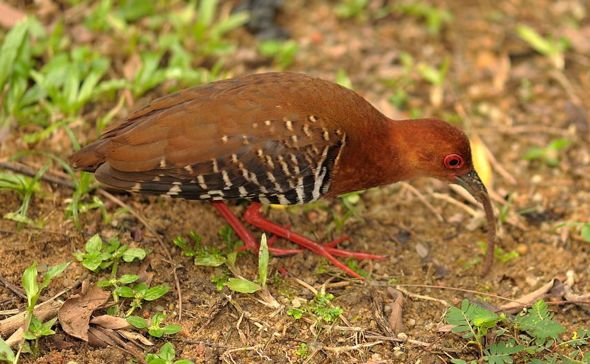 |
| Figure 12. Picture depicting a Red-legged Crake feeding on an earthworm.Photo by KC Tsang © (Permission Pending) |
Moult
The bird is different from the other birds in which, the primary moult is ascendant [1] (from the outer most primary inwards, instead of replacing from the carpal joint outwards [9]). Read more about feather moult of birds here.Breeding
The breeding season of the Red-legged Crake seems to vary according to its range [5]. During the breeding season, the breeding pairs are vocal at night. They are assumed to be monogamous, and territorial during the breeding season [1].Nesting
The eggs of the Red-legged Crake are pure white in colour [10] and were reported to be sighted in July [6]. Both parents share the responsibility of incubation. The minimum incubation period is about 18 days to hatching [10].Clutches of 5 and 6 eggs have been spotted and recorded before in Thailand, but broods of only 1 to 3 were reported in Singapore. Nests have been found to be located in forest undergrowth and near bank of small streams [1]. Juveniles are often seen either in mid-summer or in January. The juveniles are precocial and often follow the foraging adults very soon (within 2-3 days) after hatching. They are independent a few weeks later [5]. |
| Figure 13. Red-legged Crake with a nest of eggs in Thailand. |
 |
| Figure 14. Adult and juvenile Red-legged Crake. Photo by Eric Tan © |
Conservation Status
No habitat issues were identified with the Red-legged Crake [1]. Although they are very rarely seen and are not very common, they are widely distributed and therefore considered as 'Least Concern' by Birdlife International [5]. Other reasons why the Red-legged Crake is placed under 'Least Concern' in the 'Red List Category and Criteria' are that although the population trend and size are not known, the population trend is believed to not be decreasing rapidly and the population size has not approach the threshold for the 'Vulnerable' under the population size criterion [3]. For a more detailed evaluation on the conservation status of the Red-legged Crake, visit The IUCN Red List of Threatened Species - Rallina fasciata.Taxonomy and Systematics
Original Description
The protonym of the Red-legged Crake is Rallus fasciatus [11], and was first describe by Sir Stamford Raffles in 1822 from a specimen in Bengkulu, West Sumatra. It is monotypic [1]. The original description of the bird is shown in Figure15. and was printed in the Transactions of the Linnean Society of London [12] and published in 1822. No information on type specimen of Rallina fasciata were found online. |
| Figure 15. Screenshot of the original description of the Red-legged Crake (Rallus fasciatus) from The Transactions of the Linnean Society of London. |
Etymology
The generic epithet Rallina was described by G.R.Gray in 1846. The specific epithet fasciata is the feminine form of the Latin word fasciatus, which means banded [13], and it refers the extensive black and white bandings found on the underparts of the bird.Taxonomy Hierarchy
| Kingdom |
Animalia |
| Phylum |
Chordata |
| Class |
Aves |
| Order |
Gruiformes |
| Family |
Rallidae |
| Genus |
Rallina (G. R. Gray, 1846) |
| Species |
Rallina fasciata (Raffles, 1822) [19] |
Synonyms
The synonyms of Rallina fasciata [1] are provided below:1. Gallinula euryzona - Temminck, 1826
2. Rallina euryzona - Temminck, 1826
3. Hypotaenidia euryzona
4. Rallus ruficeps - Lesson 1831
5. Crex fasciata
6. Corethrura fasciata
7. Porzana fasciata - Sclater & Salvin, 1867
8. Euryzona fasciata
9. Rallina suzuki - Momiyama, 1930
Phylogeny
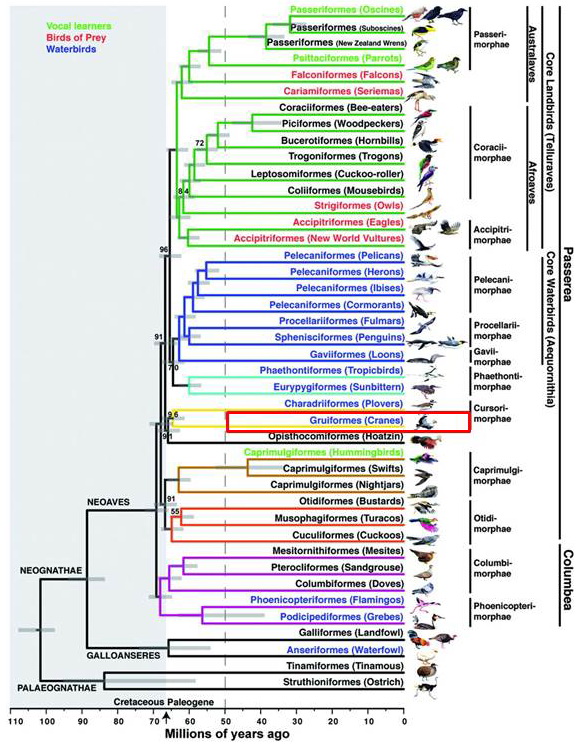 |
| Figure 16. Relationship between different taxa of birds by Jarvis et al. (2014) |
The order Gruiformes was previously thought to be phylogenetically closest to the Charadriiformes (Plovers) and the Galliformes (Landfowl) [1]. However, recent genetic studies published by Jarvis et al. (2014) has suggested that the Gruiiformes are indeed close to the Charadriiformes, but not quite to the Galliformes (refer to Figure 13). The group that Gruiiformes and Charadriiformes fall under is called Cursorimorphae (also Gruimorphae in other literature) [14].
Interestingly, the order Gruiformes served as a "waste-bin" taxon previously as all sorts of taxa were included placed under this group. The mesites, kagu and sunbittern were previously considered Gruiformes. However, recent DNA and morphological support has helped clear the mess this clade was once in. Now the clade consists of the families Rallidae (rails, crakes, gallinules and coots), Sarothururidae (Flufftails), Heliornithidae (Finfoots), Gruidae (Cranes), Aramidae (Limpkin) and Psophiidae (Trumpeters). [15] For more information, visit here.
The Rallidae family comprises of a large assemblages of birds, which have been referred to as rails, crakes, wood-rails, gallinules, moorhens and coots. However, the term 'rail' generally applies to all birds under the Rallidae family. Figure 15 shows the phylogenetic relationship of birds under the family Rallidae (the genus Rallina is highlighted in a red box). It is the largest family in the Gruiformes, and comprises of 150 species, of which 133 are extant, 2 are almost certainly extinct and 15 recently extinct (since the 17th century). These birds occupy a diverse range of habitats, ranging from the forests, wetlands and grasslands, to scrubed-covered remote islands and coral cays. Apart from coots and some moorhens which live in aquatic habitats, most of them live in dense vegetation and are difficult to observe.[16]
These birds are attractive and fascinating due to their cryptic behaviour, as well as their ability to undergo intercontinental migrations and become colonists on all parts of the world despite their poor flying abilities. The Rallidae birds are known for their proclivity towards flightlessness and yet, they are found in all parts of the world except the polar regions, waterless deserts and mountainous areas above the snowline. Interestingly, flightlessness evolved many times within the Rallidae, and occurs frequently, repeatedly and independently on islands without predator. This may be due to the high energetic cost involved in flight. [16]
Figure 15 shows the phylogenetic relationships within the Rallidae family. Three subfamilies, Rallinae, Gallinulinae and Porphyrioninae can be found in Ralidae. Figure 16 shows a higher resolution of the phylogenetic relationships within the subfamily Porphyrioninae, where the genus Rallina is embedded in. The Red-legged Crake (pointed out by the red arrow) is further classified under the clade Zarponini. The sister species of the Red-legged Crake is the Red-necked Crake (Rallina tricolor), which can be found in adjacent regions such as Papua New Guinea and Australia. The Rallina genus comprises of 8 species (4 not depicted in Figure 16, and sometimes separated into genus Rallicula) of rails which inhabits forest or marshland in forest, and are confined to Asia and Australasia [16].
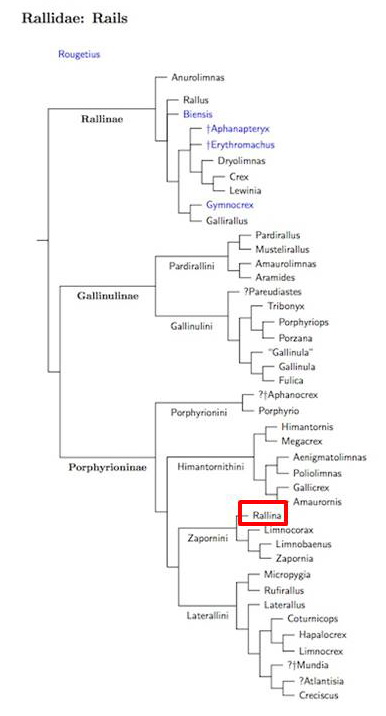 |
| Figure 17. Relationship in the order Rallidae. Edited by Soo Yun Jing. |
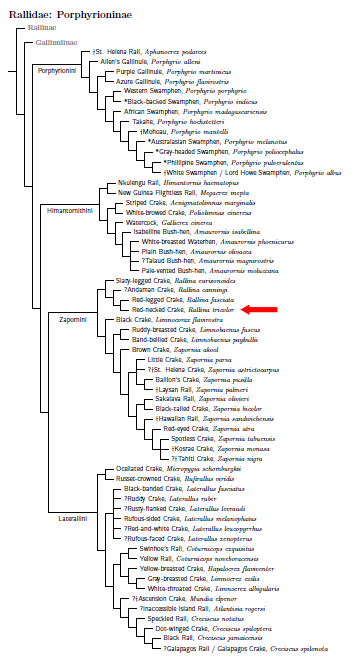 |
| Figure 18. Higher resolution relationship between Rallidae birds. Edited by Soo Yun Jing. |
DNA barcodes
Genbank contains the nucleotide sequences for cytochrome b (cytb) gene, recombination activating protein 1 (RAG-1) gene and 16s ribosomal RNA gene for Rallina fasciata. [17] The nucleotide sequences for Rallina fasciata can be retrieved here.Additional Information
1. Video of adult and chick taken at the Singapore Botanic Gardens: https://www.youtube.com/watch?v=e5JajxM9Fxw2. For more information on Rallidae birds, bird topography and detailed description of the Red-legged Crake, visit Rails: A Guide to Rails, Crakes, Gallinules and Coots of the World
3. Video of an adult and a chick filmed at the Singapore Botanic Gardens: http://ibc.lynxeds.com/video/red-legged-crake-rallina-fasciata/adult-chick-walking-together
4. More Red-legged Crake calls from xeno-canto: http://www.xeno-canto.org/species/Rallina-fasciata
5. PDF document on Rails, Coots and Crakes: http://lkcnhm.nus.edu.sg/biblio/robinson_chasen/vol3/06_Coots%20Rails%20&%20Crakes.pdf
References
1.Taylor, P. B. (1998). Rails.A Guide to Rails, Crakes, Gallinules and Coots of the World. The Banks, Mountfield, Nr. Robertsbridge, East Sussex: Pica Press, pp201-203.2.LKCNHM The DNA of Singapore, (n.d.). Rallina fasciata. [online] Available at: http://lkcnhm.nus.edu.sg/dna/organisms/details/477 [Accessed 26 Oct. 2015].
3.Birdlife International. (2012). Rallina fasciata. The IUCN Red List of Threatened Species 2012: e. T22692314A38359131. [online] Available at: http://dx.doi.org/10.2305/IUCN.UK.2012-1.RLTS.T22692314A38359131.en [Accessed 9 Nov. 2015]
4.Taylor, P.B. (1996). Red-legged Crake (Rallina fasciata). In: del Hoyo, J., Elliott, A., Sargatal, J., Christie, D.A. & de Juana, E. (eds.) (2014). Handbook of the Birds of the World Alive. Lynx Edicions, Barcelona. [online] Available at: http://www.hbw.com/node/53592 [Accessed 26 Oct. 2015]
5.Bouglouan, N. (n.d.). Red-legged Crake. [online] Oiseaux-birds.com. Available at: http://www.oiseaux-birds.com/card-red-legged-crake.html [Accessed 3 Nov. 2015].
6.Wells, D., Round, P. and Treesucon, U. (1999). The birds of the Thai-Malay Peninsula. San Diego: Academic Press.
7.Birdlife.org, (n.d.). Red-legged Crake (Rallina fasciata) - BirdLife species factsheet. [online] Available at: http://www.birdlife.org/datazone/species/factsheet/22692314 [Accessed 11 Nov. 2015].
8.Bird Ecology Study Group, (2008). Bird Ecology Study Group A family of Red-legged Crakes. [online] Available at: http://www.besgroup.org/2008/04/27/a-family-of-red-legged-crakes/ [Accessed 26 Oct. 2015].
9.Weaver, P. (1981). Topic: Descendant moult. [online] Birdcare.com. Available at: http://www.birdcare.com/bin/showdict?descendant+moult [Accessed 9 Nov. 2015].
10.Pierce, A., Khoonwongsaa, J. and Round, P. (2013). The first record and breeding attempt of Red-legged Crake Rallina fasciata at Khao Yai National Park, northeastern Thailand. 1st ed. [ebook] Natural History Bulletin of the Siam Society. Available at: http://www.siamese-heritage.org/nhbsspdf/vol051-060/NHBSS_059_1j_Pierce_TheFirstRecordAndB.pdf [Accessed 9 Nov. 2015].
11.Avibase.bsc-eoc.org, (n.d.). Rallina fasciata - Avibase. [online] Available at: http://avibase.bsc-eoc.org/species.jsp?avibaseid=1DFAA1B704669A12 [Accessed 26 Oct. 2015].
12. Raffles, T.S., (1822). Transactions of the Linnean Society of London. [online] v.13 (1822), p.328. Available at: http://www.biodiversitylibrary.org/item/13692#page/360/mode/1up [Accessed 6 Nov. 2015].
13.En.wiktionary.org, (n.d.). fasciatus - Wiktionary. [online] Available at: https://en.wiktionary.org/wiki/fasciatus [Accessed 11 Nov. 2015]
14.Jarvis, E., Mirarab, S., Aberer, A., Li, B., Houde, P., Li, C., Ho, S., Faircloth, B., Nabholz, B., Howard, J., Suh, A., Weber, C., da Fonseca, R., Li, J., Zhang, F., Li, H., Zhou, L., Narula, N., Liu, L., Ganapathy, G., Boussau, B., Bayzid, M., Zavidovych, V., Subramanian, S., Gabaldon, T., Capella-Gutierrez, S., Huerta-Cepas, J., Rekepalli, B., Munch, K., Schierup, M., Lindow, B., Warren, W., Ray, D., Green, R., Bruford, M., Zhan, X., Dixon, A., Li, S., Li, N., Huang, Y., Derryberry, E., Bertelsen, M., Sheldon, F., Brumfield, R., Mello, C., Lovell, P., Wirthlin, M., Schneider, M., Prosdocimi, F., Samaniego, J., Velazquez, A., Alfaro-Nunez, A., Campos, P., Petersen, B., Sicheritz-Ponten, T., Pas, A., Bailey, T., Scofield, P., Bunce, M., Lambert, D., Zhou, Q., Perelman, P., Driskell, A., Shapiro, B., Xiong, Z., Zeng, Y., Liu, S., Li, Z., Liu, B., Wu, K., Xiao, J., Yinqi, X., Zheng, Q., Zhang, Y., Yang, H., Wang, J., Smeds, L., Rheindt, F., Braun, M., Fjeldsa, J., Orlando, L., Barker, F., Jonsson, K., Johnson, W., Koepfli, K., O'Brien, S., Haussler, D., Ryder, O., Rahbek, C., Willerslev, E., Graves, G., Glenn, T., McCormack, J., Burt, D., Ellegren, H., Alstrom, P., Edwards, S., Stamatakis, A., Mindell, D., Cracraft, J., Braun, E., Warnow, T., Jun, W., Gilbert, M. and Zhang, G. (2014). Whole-genome analyses resolve early branches in the tree of life of modern birds. Science, 346(6215), pp.1320-1331.
15.Boyd, J. (n.d.). TiF Checklist: GRUAE I: Opisthocomiformes & Gruiformes. [online] Jboyd.net. Available at: http://jboyd.net/Taxo/List7.html [Accessed 11 Nov. 2015].
16. Taylor, B. (1998). Rails. The Banks, Mountfield, Nr. Robertsbridge, East Sussex: Pica Pres, pp26-62
17. Ncbi (n.d.). rallina fasciata - Nucleotide - NCBI. [online] Available at: http://www.ncbi.nlm.nih.gov/nuccore/?term=rallina+fasciata [Accessed 11 Nov. 2015].
18. Bastin, J., Guan, K., Ibrahim, H. and Strange, M. (2010). Natural History Drawings: The Complete William Farquhar Collection: Malay Peninsula
1803-1818. 1st ed. [ebook] Editions Didier Millet, p.181. Available at: https://books.google.com.sg/books?id=gKfkbf9fPUYC&pg=PA191&lpg=PA191&dq=slaty+legged+crake+singapore&source=bl&ots=efUEe54eE6&sig=k2yJ7n-Hv8FuzLC4Fb_WfmS_DS4&hl=en&sa=X&ved=0CDgQ6AEwBmoVChMImq-k59qHyQIV0L-OCh0kOgMV#v=onepage&q=slaty%20legged%20crake%20singapore&f=false [Accessed 11 Nov. 2015].
19.Itis.gov, (n.d.). ITIS Standard Report Page: Rallina fasciata. [online] Available at: http://www.itis.gov/servlet/SingleRpt/SingleRpt?search_topic=TSN&search_value=176312 [Accessed 3 Nov. 2015]
20.Bird Ecology Study Group, (2008). Bird Ecology Study Group A family of Red-legged Crakes. [online] Available at: http://www.besgroup.org/2008/04/27/a-family-of-red-legged-crakes/ [Accessed 26 Oct. 2015].
21.Oriental Bird Images, (2013). Oriental Bird Club Image Database : Red-legged Crake » Rallina fasciata. [online] Available at: http://orientalbirdimages.org/search.php?Bird_ID=798 [Accessed 26 Oct. 2015].
22."Crake, Red-legged," by Con Foley. PBase, 2009. Available at: http://www.pbase.com/con_foley/image/109069560 [Accessed 3 Nov. 2015].
23."Red-legged Crake - Rallina fasciata," by Albert Noorlander. Pbase, 16 July 2013. Available at: http://www.pbase.com/albert_noorlander/image/151879829 [Accessed 8 Nov. 2015].
24. Robinson, and Chasen, (1927). Coots, Rails and Crakes. 1st ed. [pdf] pp.67-84. Available at: http://lkcnhm.nus.edu.sg/biblio/robinson_chasen/vol3/06_Coots%20Rails%20&%20Crakes.pdf [Accessed 26 Oct. 2015].
25."Encounter with a dead Red-legged Crake," by Amar-Singh HSS. Bird Ecology Study Group, 19 November 2009. Available at: http://www.besgroup.org/2009/11/19/encounter-with-a-dead-red-legged-crake/ [Accessed 8 Nov. 2015].
26."Red-legged Crake," by Eric Tan. Nature Pixels, 11 February 2008. Available at: http://www.naturepixels.org/phpBB3/viewtopic.php?f=5&t=1912 [Accessed 26 Oct. 2015].
27. "A Red-legged Crake crossing the pavement at Singapore Botanical Gardens, in full view of everyone,". Singapore Bird Group, 24 April 2015. Available at: https://singaporebirdgroup.wordpress.com/2015/04/24/destination-singapore-a-birders-gateway-to-the-jungles-of-southeast-asia-part-2/red-legged-crake-2/ [Accessed 9 Nov. 2015].
28. "Mousedeer and Snake Encounter," by Con Foley. Con Foley Photography, 2013. Available at: http://confoley.com/mousedeer-and-snake-encounter [Accessed 9 Nov. 2015].
29. "Band-bellied Crake," by Yau. HK Wildlife, 8 May 2009. Available at: http://www.hkwildlife.net/Forum/viewthread.php?tid=45122 [Accessed 9 Nov. 2015].
30. "Ruddy-breasted Crake," by wokoti. Flickr, 16 February 2014. Available at: https://www.flickr.com/photos/wokoti/12553669165 [Accessed 9 Nov. 2015].
31. 23.Xeno-canto.org, (n.d.). Red-legged Crake (Rallina fasciata) :: xeno-canto. [online] Available at: http://www.xeno-canto.org/species/Rallina-fasciata [Accessed 11 Nov. 2015].
32.Tjalle Boorsma, XC33425. [online] Accessible at www.xeno-canto.org/33425 [Accessed 26 Oct. 2015]
33.Yong Ding Li, XC57232. [online] Accessible at www.xeno-canto.org/57232 [Accessed 26 Oct. 2015]
34.Explore and discover Red List species ranges and observations, (n.d.). IUCN Red List maps. [online] Available at: http://maps.iucnredlist.org/map.html?id=22692314 [Accessed 9 Nov. 2015].
35."Red Legged Crake & Chick-Singapore Botanic Gardens," by Jeremiah Loei. Youtube, 27 February 2014. Available at: https://www.youtube.com/watch?v=e5JajxM9Fxw [Accessed 9 Nov. 2015].
36."Another Red-legged Crake Found Dead," by Tan Gim Cheong. Bird Ecology Study Group, 25 December 2009. Available at: http://www.besgroup.org/2009/12/25/another-red-legged-crake-found-dead/#comments [Accessed 9 Nov. 2015].
37."Red-legged Crake bathing," by Nick Upton. Youtube, 5 July 2015. Available at: https://www.youtube.com/watch?v=Mp9SW8DeL_w [Accessed 11 Nov. 2015].
38."Red-legged Crake and Earthworms," by KC Tsang. Bird Ecology Study Group, 29 January 2010. Available at: http://www.besgroup.org/2010/01/29/red-legged-crake-and-earthworms/ [Accessed 9 Nov. 2015].
39."Red-legged Crake teaching Chick how to hunt for food," by Jeremiah Loei. Youtube, 27 February 2014. Available at: https://www.youtube.com/watch?v=yUnL7anGrgE [Accessed 9 Nov. 2015].
40."Red-legged Crake,". Birds of Thailand: Siam Avifauna, 13 June 2003. Available at: http://www.birdsofthailand.org/photo/2989 [Accessed 11 Nov. 2015].
